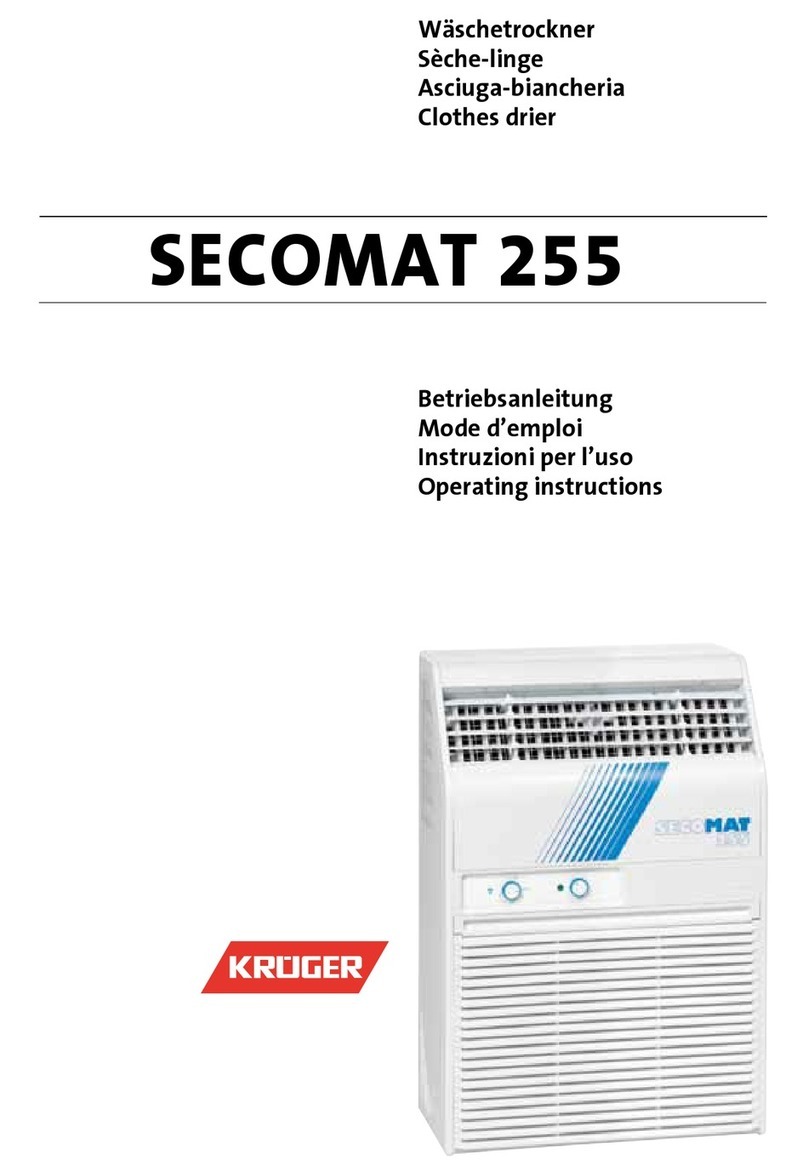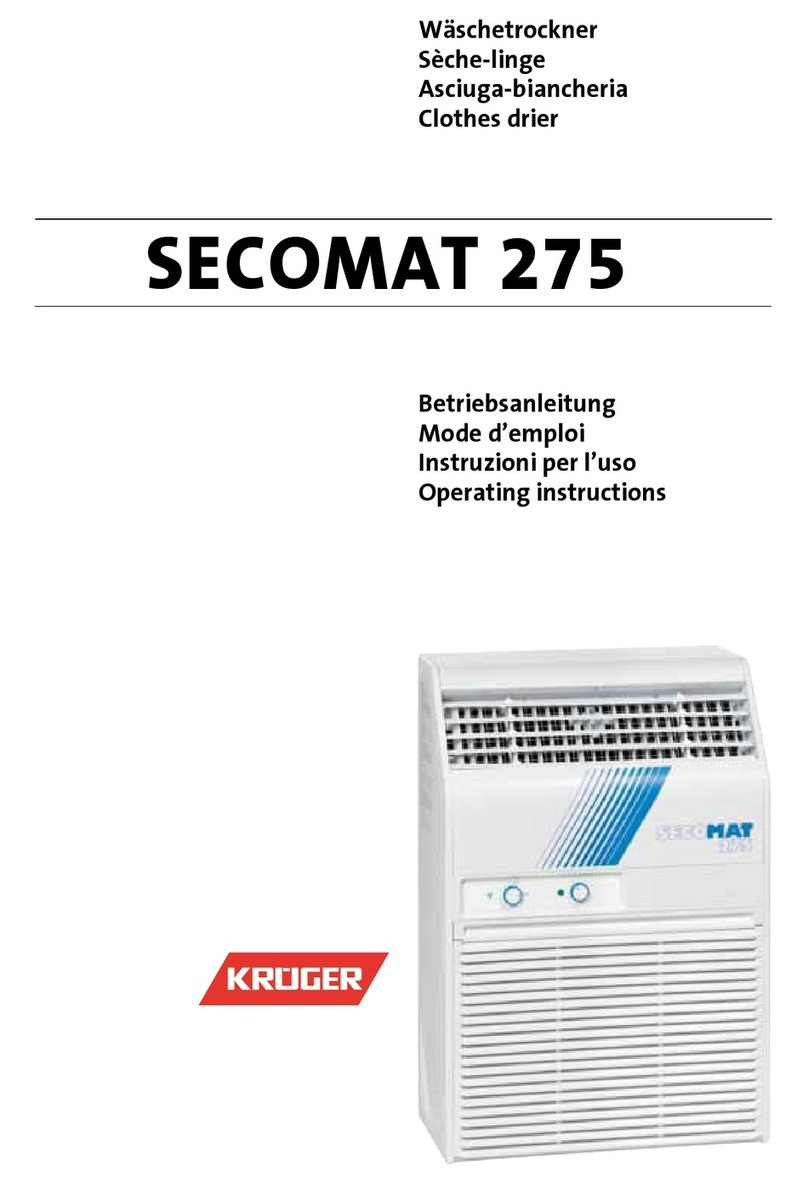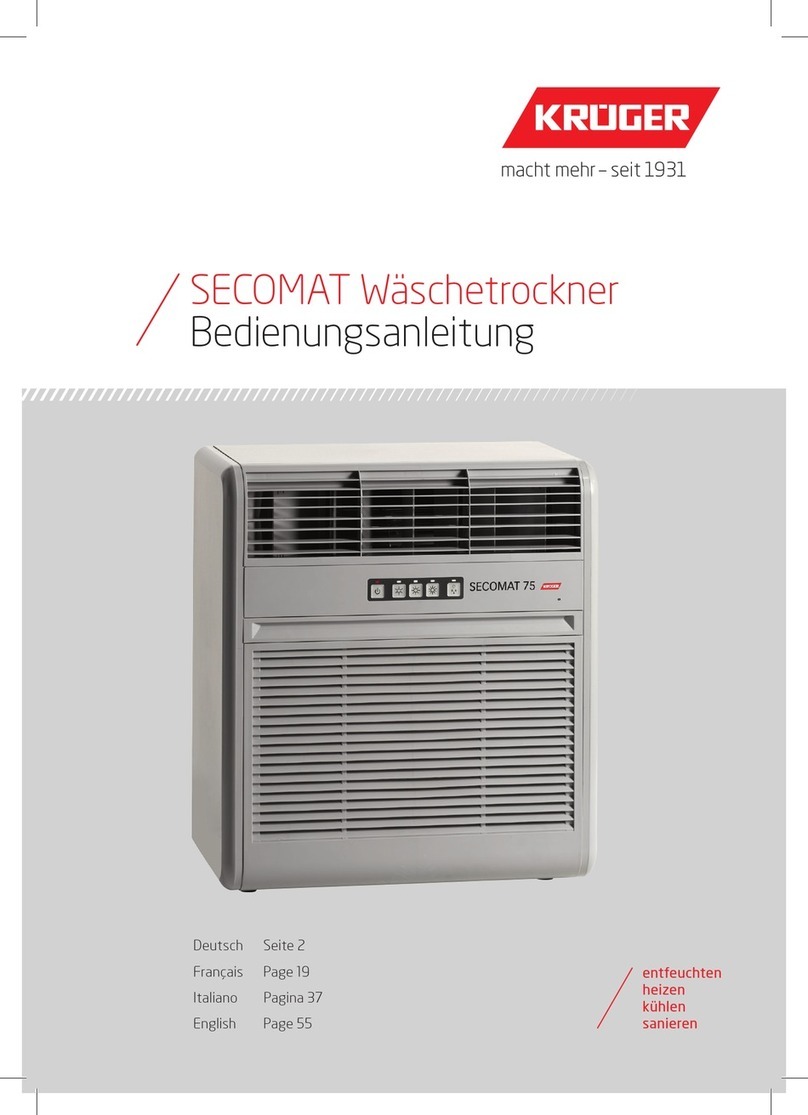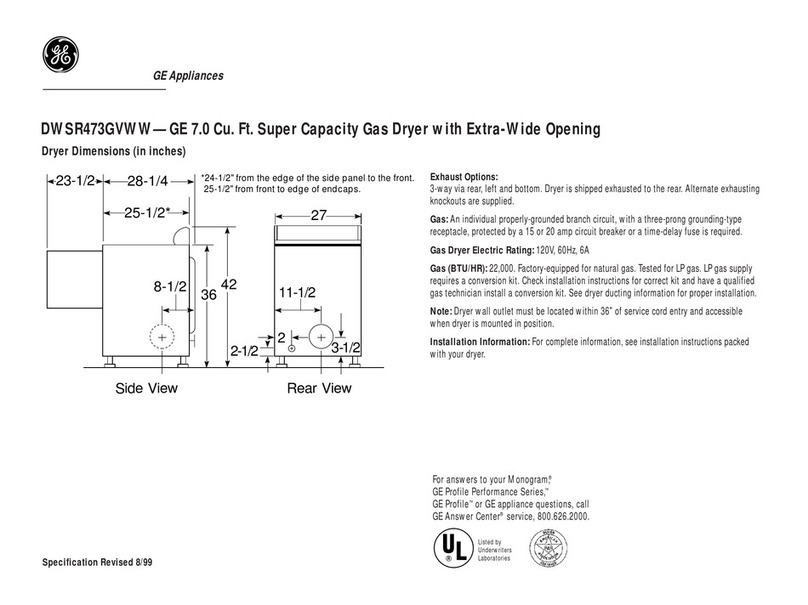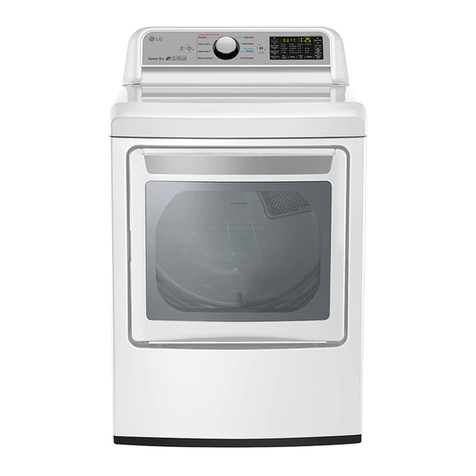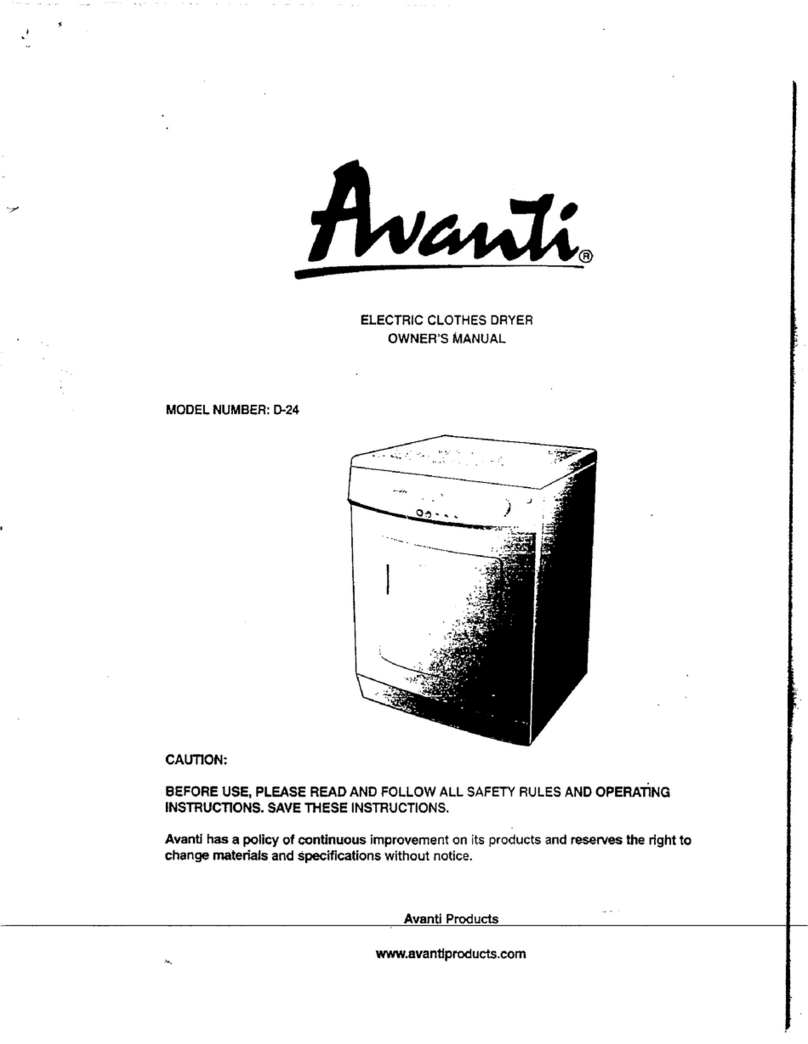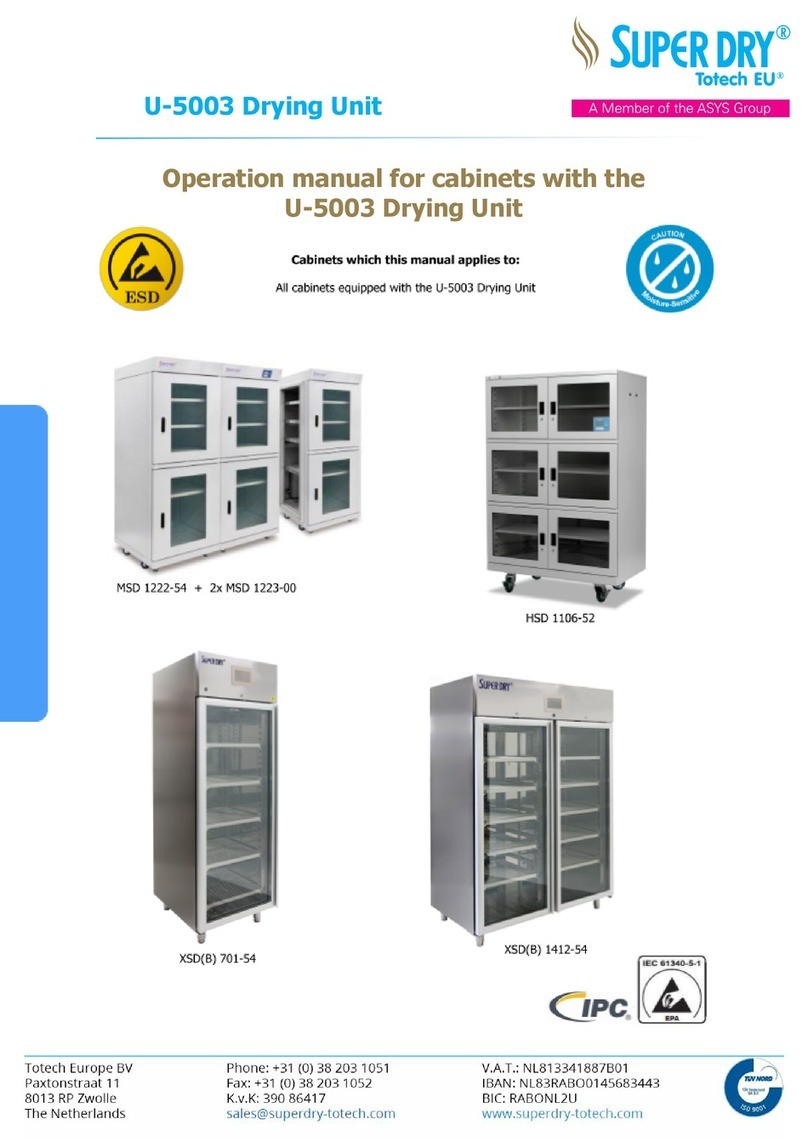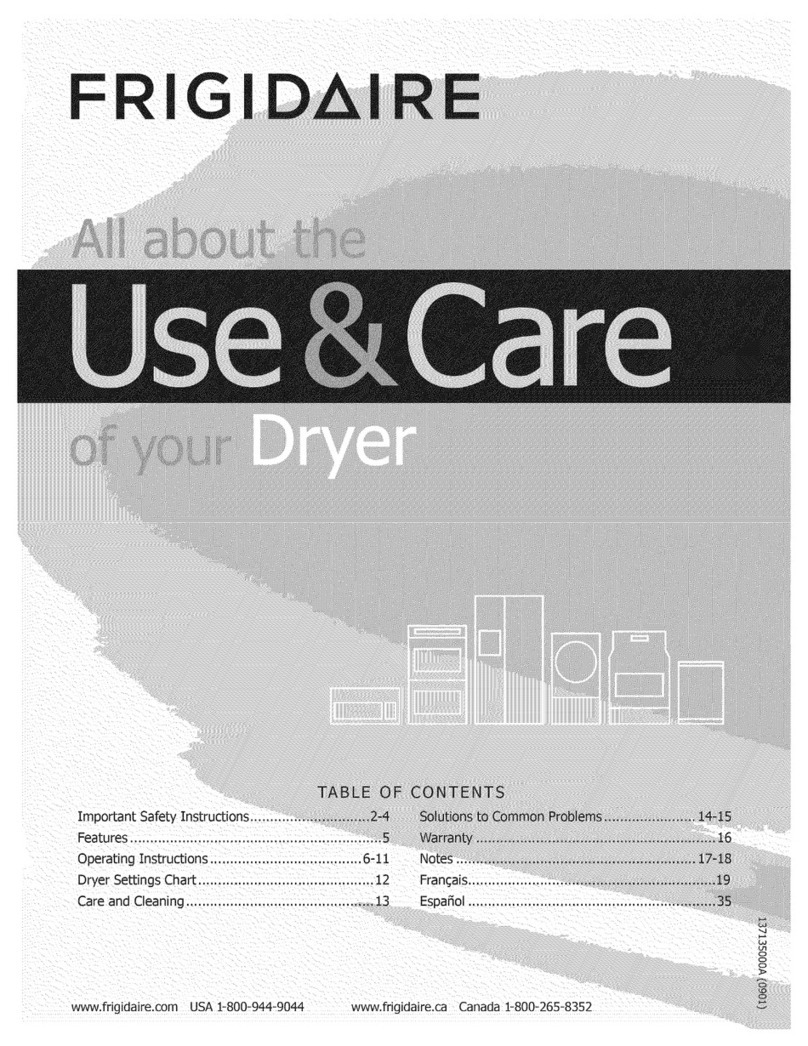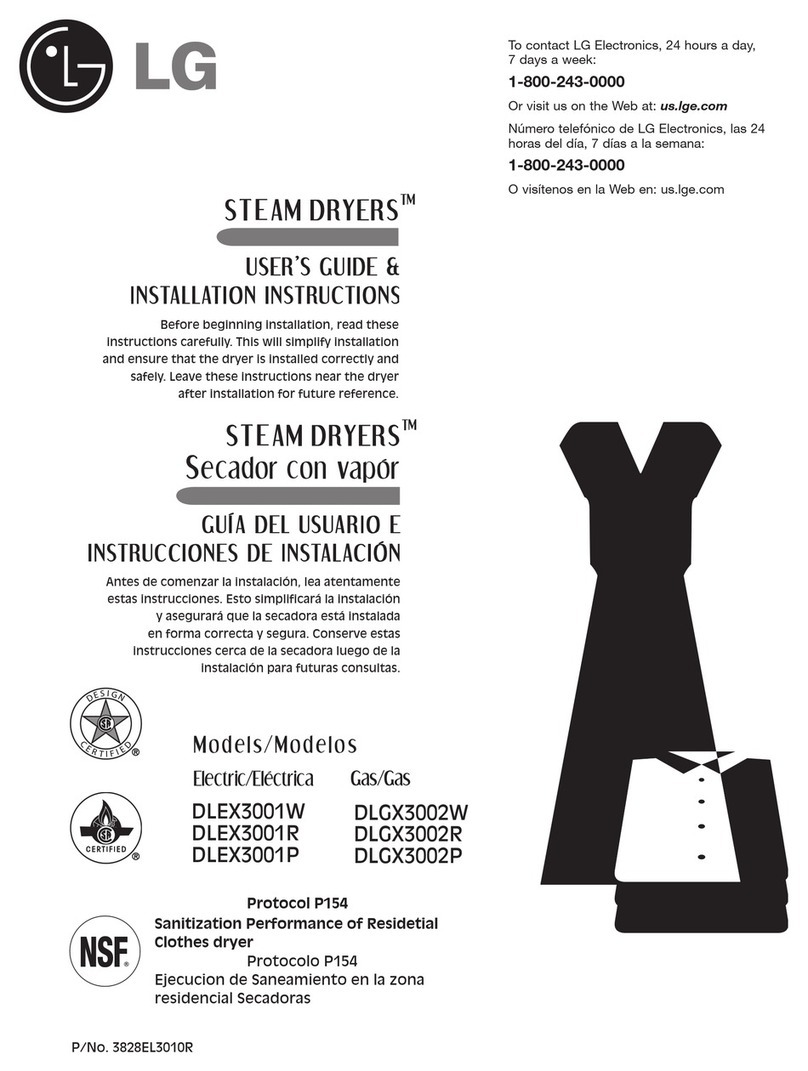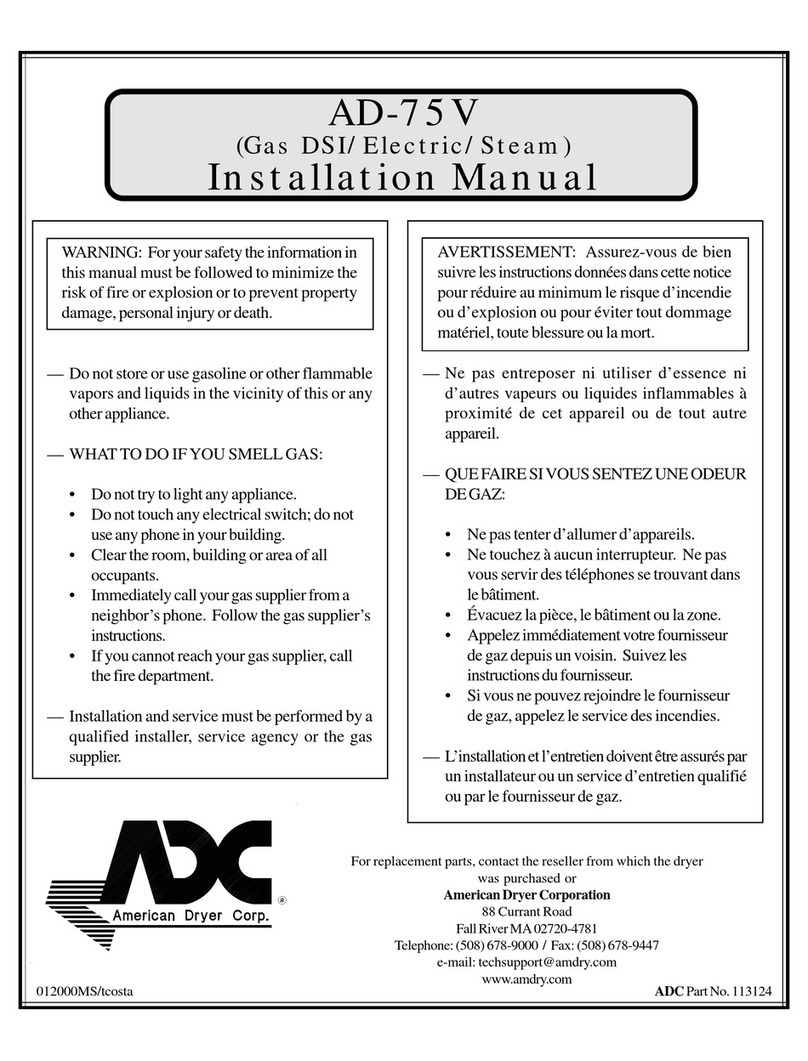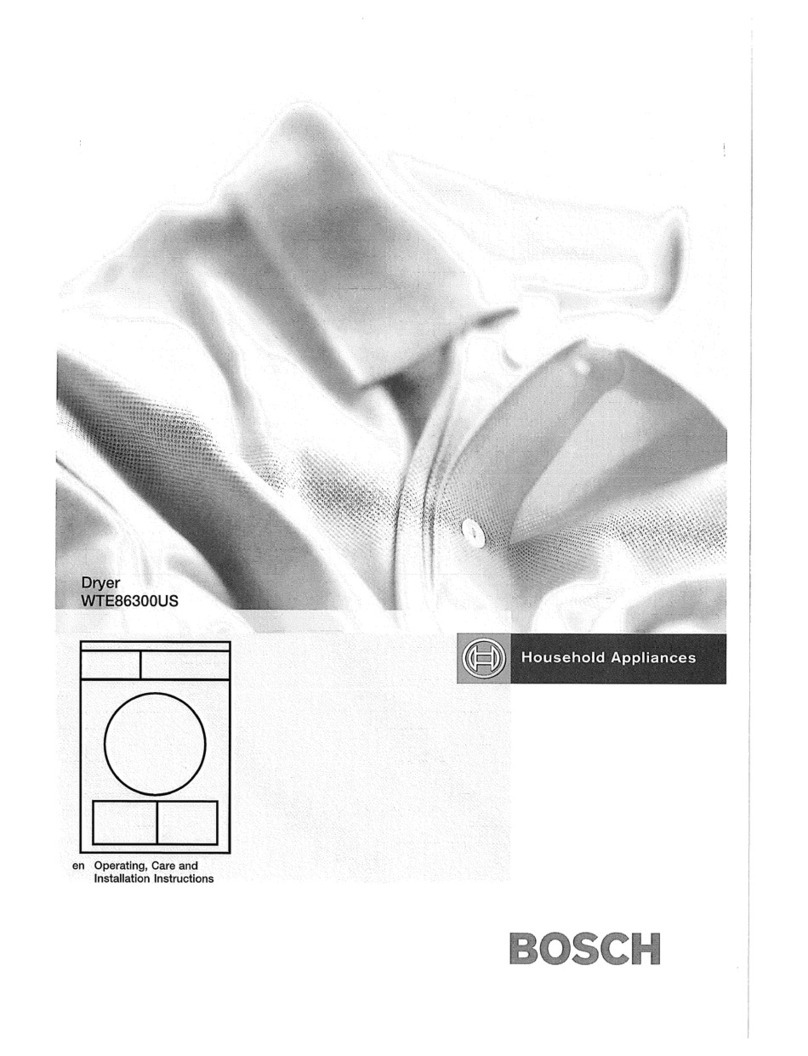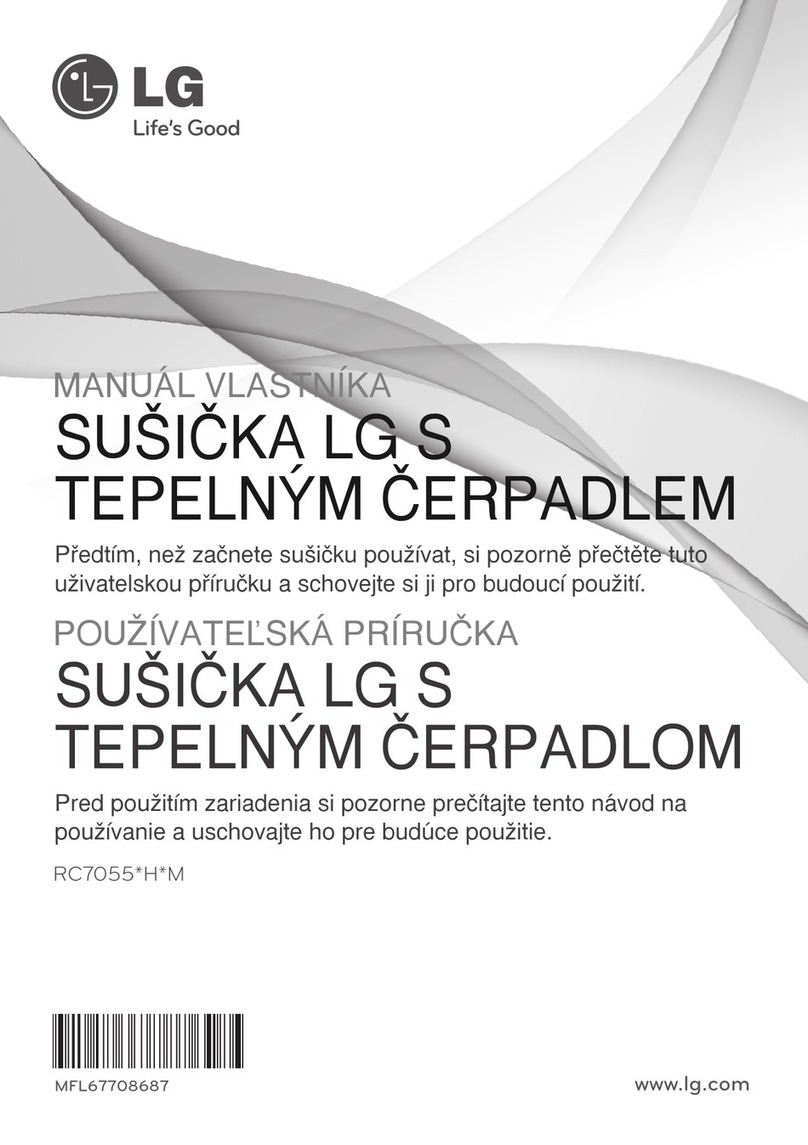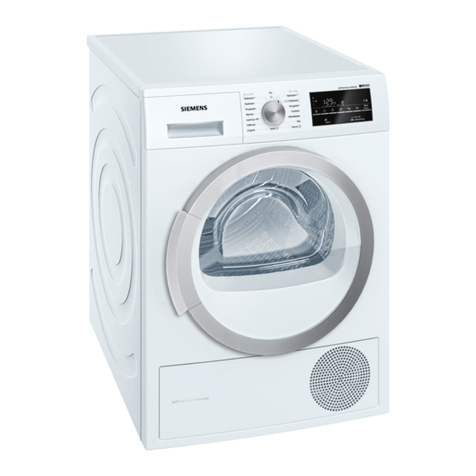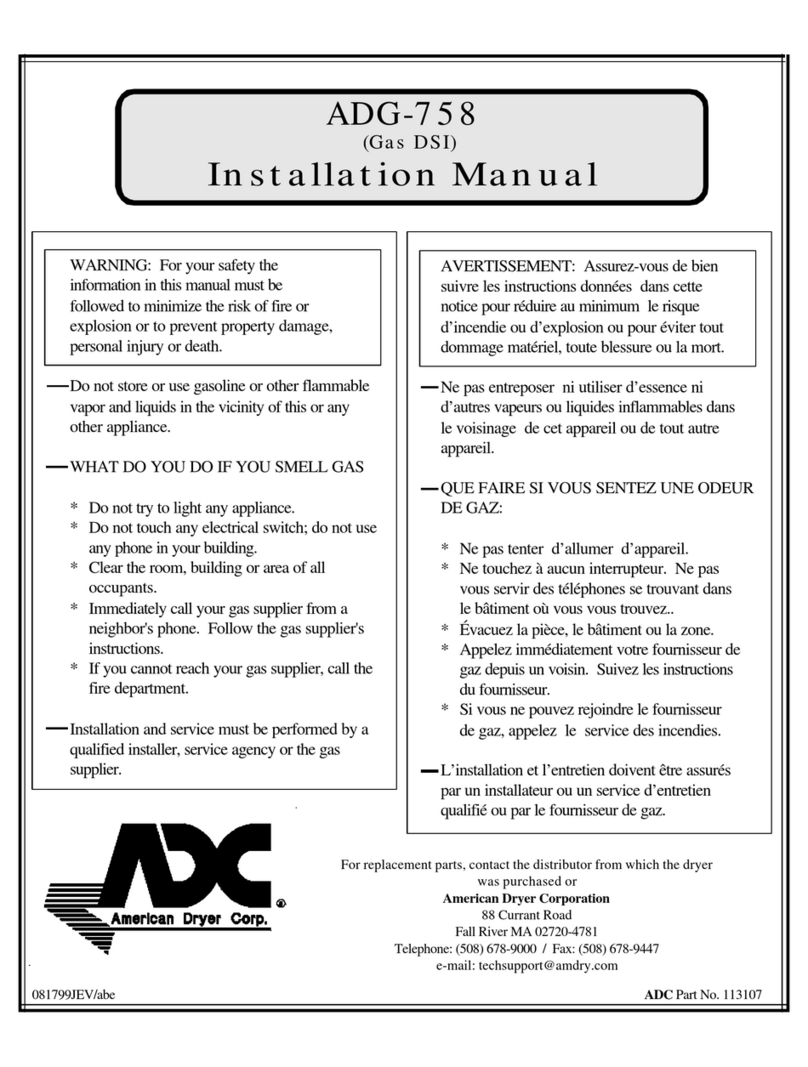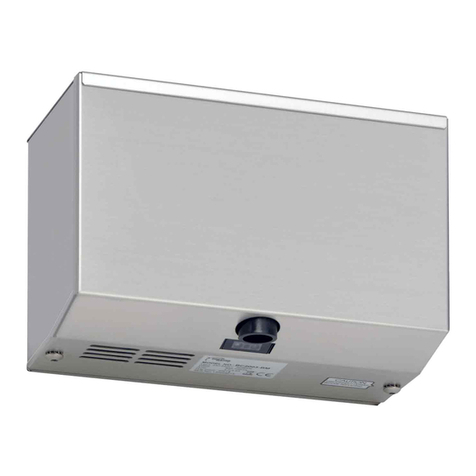Kruger SECOMAT 160 User manual

Wäschetrockner
Sèche-linge
Asciuga-biancheria
Clothes drier
Betriebsanleitung
Mode d’emploi
Instruzioni per l’uso
Operating instructions
SECOMAT 160

1
7
6
3
2
4
5
1
Hygrostatknopf
Bouton de l‘hygrostat
Selettore igrostato
Hygrostat controller
2
grüne Betriebslampe
Lampe-témoin verte
Spia d‘esercizio verde
Power indicator light (green)
3
Ein-/Aus-Schalter
Interrupteur principal en/hors
Interuttore acceso/spento
On/Off switch (I), Off switch (O)
4
Filtergriff
Poignée du filtre
Maniglia filtro
Filter grip
5
Frontgitter
Grille frontale
Griglia frontale
Front grill
6
Ausblasgitter
Gille d‘émission
Griglia emissione
Outlet grill
7
Direktablauf-Stutzen
Raccord pour écoulement direct
Raccordo per scarcio diretto
Direct drain plug

ANLEITUNG
Transport/Lagerung
Das Gerät sollte, wenn immer möglich,
aufrecht transportiert werden. Nach
einem liegenden Transport muss das
Gerät mindestens zwei Stunden auf-
recht hingestellt werden, bevor es an-
geschlossen und in Betrieb genommen
werden darf.
Sollte das Gerät längere Zeit nicht in Ge-
brauch sein, so muss vor der Einlagerung
das Gehäuse mit einem feuchten Lappen
gereinigt und dann trockengerieben wer-
den. Das Gerät sollte dann verpackt wer-
den (Originalkarton).
Montage der Wäscheleine
Um ein optimales Trocknungsergebnis
zu erzielen, montieren Sie die Wäsche-
leine bitte wie folgt:
Falsch:
Die quer zum Trockner aufgehängte Wä-
sche behindert den Luftstrom und be-
wirkt,dassdieweiterhintenaufgehängte
Wäsche viel langsamer trocknet.
Gut:
Hier kann die Luft zirkulieren und erreicht
auch die hintersten Wäschestücke.
Am Besten:
Das von Krüger entwickelte Sonnenlei-
nen-System ist optimal auf die Konden-
sationstrocknungsmethode abgestimmt
und bringt die kürzesten Trocknungs-
zeiten.
Aufstellung des
Wäschetrockners
• BeiliegendeBefestigungsschiene60cm
unter der Wäschehänge an die Wand
montieren (wenn möglich an eine In-
nenwand, um eine Kondens-wasserbil-
dung hinter dem Gerät zu vermeiden)
• Gerät in diese Schiene einhängen und
mit den links und rechts angebrachten
Schrauben gegen unbeabsichtigtes
Aushängen sichern
• Sicherheitsabstand von 8 cm zu brenn-
baren Teilen einhalten
Betriebstemperaturen
160 E: min. +15°C, max. +30°C
160 AH: min. +8°C, max. +30°C
Beim Modell E ist das Heizelement nicht
aktiviert. Dieses Gerät arbeitet deshalb
nur im Temperaturbereich von +15°C
bis +30°C einwandfrei. Wird das Gerät
im Temperaturbereich unter +15°C ein-
gesetzt, kann eventuell eine Vereisung
des Kühlelements auftreten. In diesem
Fall muss das Heizelement durch den
Servicetechniker aktiviert werden. Diese
Betriebsart ist nach Möglichkeit zu ver-
VOR DEM BENUTZEN
Bitte lesen Sie alle in dieser Gebrauchs-
anweisung aufgeführten Informationen
aufmerksam durch. Sie geben Ihnen
wichtige Hinweise für den Gebrauch,
die Sicherheit und den Unterhalt des
Gerätes.
Bewahren Sie diese Gebrauchsanwei-
sung sorgfältig auf und geben Sie diese
gegebenenfalls an Nachbenutzer wei-
ter.
Das Gerät darf nur für den vorgesehenen
Zweck, gemäss dieser Gebrauchsan-
weisung verwendet werden. Beachten
Sie die Sicherheitshinweise.
SICHERHEITSHINWEISE
• Dieses Gerät ist kein Kinderspielzeug.
Kinder erkennen die Gefahren nicht,
die beim Umgang mit Elektrogeräten
entstehen können. Das Gerät muss
deshalb ausser Reichweite von Kin-
dern benutzt und aufbewahrt wer-
den.
• Der Wäschetrockner darf nur entspre-
chend den nationalen Anschlussbe-
dingungen installiert werden.
• Finger und Gegenstände dürfen nie in
dieGeräteöffnungen gehaltenwerden.
Verletzungsgefahr!
• Gerät immer ausschalten, wenn es
nicht benutzt wird.
• Verhindern Sie den Kontakt des Elek-
trokabels mit einer heissen Ober-
fläche.
• Den Netzstecker ziehen:
a) bei Störungen
b) vor jeder Reinigung und Pflege
c) nach Gebrauch
• Den Stecker niemals am Netzkabel
oder mit nassen Händen aus der Steck-
dose ziehen.
• Das Gerät nie am Netzkabel ziehen.
• Das Netzkabel nicht über scharfe
Kanten ziehen oder einklemmen.
• Verlängerungskabel nur dann ver-
wenden, wenn Sie sich zuvor von des-
sen einwandfreiem Zustand überzeugt
haben. Bei einer Kabelrolle ist das ge-
samte Kabel von der Rolle zu ziehen.
• Das Gerät ist nicht in Betrieb zu neh-
men (Netzstecker sofort ziehen) wenn:
a) das Gerät oder Netzkabel beschä-
digt ist.
b) der Verdacht auf einen Defekt nach
einem Sturz oder ähnlichem be-
steht.
In diesem Fall muss das Gerät durch
einen Fachmann (Kältespezialist) kon-
trolliert und eventuell repariert wer-
den.
• Das Gerät darf nie in stehendem
Wasser benützt werden. Sollte dies
der Fall sein, so muss das Gerät zu-
erst ausgesteckt oder die Sicherung
rausgeschraubt werden, bevor man
die Wasserlache betritt.
• Keine schweren Gegenstände auf das
Gerät stellen oder sich darauf setzen.
• Wird das Gerät zweckentfremdet,
falsch bedient oder nicht fachgerecht
repariert, kann keine Haftung für even-
tuelle Schäden übernommen werden.
In diesem Fall entfällt der Garantiean-
spruch.
VERWENDUNGSZWECK
Dieses Gerät ist speziell für die Wäsche-
trocknung konzipiert.
SYSTEM-BESCHREIBUNG
Die feuchte Raumluft wird mittels eines
Ventilators über den am Kühlaggregat
angeschlossenen Verdampfer geführt.
Die Feuchtigkeit kondensiert an den
Verdampfer-Schlangen und tropft als
Wasser in die Tropfwanne ab. Vor dem
Austritt wird die Luft durch den Konden-
sator wieder auf die Eingangstemperatur
erwärmt.

DRY
STOP
20
30 40
50
60
70
DRY
STOP
20
30 40
50
60
70
Raumfeuchtigkeit beginnt das Gerät
erneut zu arbeiten.
• Abschalten: Schalter „I“ drücken
• SECOMAT 160 E
(mit Endabschaltung)
• Einschalten: Schalter „I“ drücken
Der Wäschetrockner arbeitet automa-
tisch, d.h. solange die im Raum herr-
schende Feuchtigkeit über dem einge-
stellten Wert liegt, wird entfeuchtet.
Sobald der eingestellte Feuchtigkeits-
grad erreicht ist, schaltet der Wä-
schetrockner komplett ab, d.h. er
schaltet sich auch bei Wiederanstieg
der Raumfeuchtigkeit nicht mehr ein.
Durch drücken des Schalters „0“ kann
der Trockenvorgang jederzeit abgebro-
chen werden.
Reinigung
Das Kälteaggregat ist hermetisch ver-
schlossen, die Lager des Ventilators sind
dauergeschmiert und bedürfen deshalb
keiner Wartung.
• Gehäuse mit einem feuchten Tuch ab-
wischen
• Den am oberen Ende des Frontgitters
(5) ersichtlichen Filtergriff (4) fassen
und Filter nach oben ziehen.
• Luftfilter mit einer Bürste entstauben
und wieder einsetzen
Bei starker Verschmutzung ist eine In-
nenreinigung des Gerätes notwendig. Di-
ese Unterhaltsarbeit muss durch einen
Kältefachmann ausgeführt werden.
STÖRUNGSKONTROLLE
Bitte kontrollieren Sie die nachstehenden
Punkte, bevor Sie das Gerät zu Ihrem
Fachhändler bringen:
A. Gerät läuft nicht
•
Ist der Netzstecker korrekt eingesteckt?
• Ist die Sicherung Ihres Elektrokastens
in Ordnung?
• Ist das Netzkabel oder das eventuell
verwendete Verlängerungskabel in
Ordnung?
• Ist der Hygrostatschalter richtig einge-
stellt (ca. 45%)?
B. Gerät läuft ununterbrochen
• Ist das Hygrostatrad auf einen Wert
von ca. 45% r.F. eingestellt?
• Sind die Türen und Fenster ge-
schlossen?
C. Das Gerät entfeuchtet nur
ungenügend
• IstdieLuftzirkulationimRaumgewähr-
leistet? Mit den Ausblaslamellen kann
der Luftstrom verändert werden, sie
dürfen aber nicht geschlossen sein.
• Sind die Ansaug- und Ausblas-Öffnun-
gen frei?
• Ist die Raumtemperatur zu hoch oder
zu niedrig (s. Rubrik Aufstellung)?
• Ist der Filter sauber?
Sollte die Kontrolle obiger Punkte zu
keinem Erfolg führen, so muss das Ge-
rät einem Fachmann (Kältespezialisten)
zur Inspektion übergeben werden.
ENTSORGUNG
Der Luftentfeuchter ist mit einem Kälte-
mittel gefüllt. Eine spezielle Entsorgung
ist deshalb notwendig. Bitte wenden Sie
sich an Ihren Fachhändler oder die ört-
liche Entsorgungsstelle.
meiden, da der Stromverbrauch im Be-
trieb mit Heizung ansteigt. Das Modell
AH ist mit einem Heizelement ausge-
rüstet, welches sich unter +15°C auto-
matisch zuschaltet. Diese Heizung dient
nur zur Unterstützung der Gerätefunk-
tion, nicht als Raumheizung.
Wasserableitung
Das Wasser sollte, wenn immer möglich,
direkt abgeleitet werden.
• Anschluss-Stück (Sonderzubehör) am
Gewinde (7) an der Unterseite des Ge-
rätes anbringen
• Schlauch (Sonderzubehör) über An-
schluss-Stück stülpen
• Schlauchende in Ablaufrohr (vorzugs-
weise siphoniert) führen
Wird das Wasser in einem Eimer auf-
gefangen, so muss dieser regelmässig
kontrolliert und allenfalls entleert wer-
den. Je nach Temperatur und Feuchtig-
keitsgehalt der Luft kann sich der Eimer
1 – 2x täglich füllen.
Ein Nichtentleeren des Eimers verursacht
einen Wasserschaden.
Aufhängen der Wäsche
• Wäsche nicht näher als 30 cm zum Ge-
rät aufhängen
• SchwereWäschestückeausBaumwolle
(z.B. Frottéewäsche, Jeans, Pullover) in
der Nähe des Gerätes in den Luftstrom
hängen
• Grosse Wäschestücke über zwei Seile
hängen oder an zwei Leinen befes-
tigen
• Luftzirkulation innerhalb des Raumes
gewährleisten
• Ansaug- und Ausblasöffnungen nicht
verdecken
Die wirtschaftlichste Trocknung erzielen
Sie, indem der Wäschetrockner erst in Be-
trieb genommen wird, wenn:
a) die gesamte Wäschemenge aufge-
hängt ist.
b) der Trockenraum voll ist.
Wird während des Trockenvorganges
Wäsche dazugehängt, verlängert sich
die Trocknungsdauer.
Inbetriebnahme
• Fenster und Türen schliessen
• Kontrolle ob Netzstecker in Steckdose
• Hygrostatknopf (1) auf 45% r.F. (Wä-
sche ist trocken) einstellen. Sollte der
Trockengrad der Wäsche nicht Ihren
Vorstellungen entsprechen, so kann
dieser wie folgt geändert werden:
Wäsche ist nicht trocken genug
Hygrostat auf 35 – 40% einstellen
Wäsche ist zu trocken
Hygrostat auf 50 – 55% einstellen
• SECOMAT 160 AH
• Einschalten: Schalter „I“ drücken
Der Wäschetrockner arbeitet automa-
tisch, d.h. solange die im Raum herr-
schende Feuchtigkeit über dem einge-
stellten Wert liegt, wird entfeuchtet.
Sobald der eingestellte Feuchtig-
keitsgrad erreicht ist, unterbricht der
WäschetrocknerdieEntfeuchtungsfunk-
tion. Bei einem Wiederanstieg der

INSTRUCTIONS
Transport/Entreposage
Dans la mesure du possible, l’appareil
doit être transporté debout. Après un
transport en position couchée, l’appa-
reil doit être placé debout pendant deux
heures au minimum avant d’être rac-
cordé et mis en service.
Si l’appareil n’est pas utilisé pendant
une periode prolongée, le bac à eau et
le caisson doivent être nettoyés à l’aide
d’un chiffon humide et être séchés. Pour
l’entreposage, il est conseillé d’emballer
l’appareil (de préférence dans son car-
ton d’origine).
Montage de la corde à linge
Pour garantir un séchage optimal, nous
vousconseillonsdesuivrelesrecommand-
ations suivantes:
Faux:
La disposition perpendiculaire des cor-
des à linge par rapport au sèche-linge
empêche le flux d’air de circuler libre-
ment ralentissant fortement le proces-
sus de séchage du linge suspendu plus
en arrière.
Correct:
Cette configuration permet à l’air de cir-
culer et d’atteindre le linge suspendu en
bout de corde.
Optimal:
Le système d’étendage Sun-Line mis
au point par Krüger est parfaitement
adapté à la méthode de séchage par
condensation et offre les temps de
séchage les plus courts.
Installation de l’appareil
• Fixer au mur le rail de montage livré à
une distance de 60 cm en dessous de
l’étendage (si possible sur un mur inté-
rieur, afin de prévenir toute formation
de condensats derrière l’appareil).
• Accrocher l’appareil sur ce rail et l’as-
surer au moyen des vis placées aux
deux extrémités
• Maintenir une distance minimale de
8 cm par rapport aux pièces inflam-
mables
Température de service
160 E: min. +15°C, max. +30°C
160 AH: min. +8°C, max. + 30°C
Sur le modèle E, l’élémet de chauffage
n’est pas activé. Par consequent, cet
appareil travaille correctement dans une
plage de température de +15°C à +30°C.
En cas d’utilisation de l’appareil dans une
plage de température inférieure à +15°C,
il y a risque de givrage de l’élément de
refroidissement.Danscecas,l’élémentde
chauffagedoitêtreactivéparletechnicien
de service. Ce mode de fonctionnement
doit si possible être évité car entaînant
AVANT LA PREMIERE
UTILISATION
Lisez attentivement ce mode d’emploi, il
contient toutes les informations impor-
tantes sur l’utilisation, les mesures de
sécurité et l’entretien de l’appareil.
Conservez ce mode d’emploi dans un
endroit sûr et remettez-le, le cas échéant,
au prochain utilisateur.
L’appareil ne doit être utilisé que pour
l’usage prévu conformément à cette
notice. Veuillez observer les consignes
de sécurité.
CONSIGNES DE SECURITE
• Cet appareil n’est pas destiné aux
enfants. Les enfants ne sont pas en
mesure de reconnaître les dangers que
peut présenter l’utilisation d’appareils
électriques. L’utilisation et l’entrepo-
sage de l’appareil doivent avoir lieu
dans un endroit hors de portée des
enfants.
• Ne jamais mettre les doigts ou autres
objets dans les ouvertures de l’appareil.
Risque d’accident!
• Le raccordement du sèche-linge doit
être conforme aux prescriptions natio-
nales.
• Lorsque l’appareil n’est pas utilisé, il
doit être déconnecté.
• Le câble ne doit pas être mis en contact
avec une surface chaude.
• Le câble d’alimentation doit être retiré
dans les cas suivants:
- lors d’un dérangement
- avant chaque nettoyage ou
entretien
- après utilisation
• La fiche ne doit jamais être retirée en
tirant sur le câble d’alimentation ou
avec les mains mouillées.
• L’appareil ne doit jamais être déplacé
en le tirant par le câble.
• Le câble ne doit pas être en contact
avec des arêtes vives ou être écrasé.
• Seules les rallonges en parfait état doi-
vent être employeés. Si vous utilisez un
enrouleur de câble, il faut dérouler en-
tièrement le câble.
• Il est interdit de mettre l’appareil en
service (la fiche doit être immédiat-
ement retirée) lorsque:
- l’appareil ou le câble
d’alimentation est endommagé.
- la présence d’un défaut suite à un
choc ne peut pas être exclu.
Dansce cas,l’appareildoitêtrecontrôlé
par une personne qualifiée (spécialiste
du froid) et au besoin être réparé.
• Il est strictement interdit de faire fonc-
tionner l’appareil dans de l’eau. Si un
tel cas devait se produire, il faut en pre-
mier retirer l’alimentation électrique
ou dévisser le fusible avant d’entrer
en contact avec l’eau.
• Aucun objet lourd ne doit être posé sur
l’appareil. Il est également interdit de
s’asseoir dessus.
• Nous déclinons toute responsabili-
té sur d’éventuels défauts découlant
d’une utilisation inadaptée ou d’une
réparation inappropriée. Dans ce cas,
la garantie devient caduque.
FONCTION
Cet appareil a été conçu pour le séchage
du linge.
FONCTIONNEMENT
L’air humide en provenance du local est
amené sur un evaporateur au moyen
d’un ventilateur. L’humidité se condense
sur les serpentins et s’égoutte dans une
cuvette de rétention. Le condenseur ré-
chauffe l’air à la température ambiante
avant de le souffler.

• SECOMAT 160 E
(avec arrêt definitif)
• Mise en marche: actionner l’interrup-
teur „I“
Le fonctionnement du sèche-linge est
automatique, c’est-à-dire l’appareil fonc-
tionne aussi longtemps que le taux d’hu-
midité de l’air est supérieur à la valeur de
consigne. Au moment où ce taux corres-
pond à la valeur préréglée, il s’arrête de-
finivement et ne remet pas en marche
même si l’humidité de l’air augmente de
nouveau.L’interrupteur„0“permetàtout
instant d’interrompre le processus de sé-
chage.
Nettoyage
Les parties mobiles de l’appareil sont fer-
mées hermétiquement. Les roulements
du moteur du ventilateur sont graissés a
vie et ne demandent aucun entretien.
• Passer un chiffon humide sans déter-
gent sur le caisson
• Saisir le poignée du filtre (4) visible sur
la partie supérieure de la grille frontale
(5) et retirer le filtre contre en haut
• Nettoyer le filtre à l’aide d’une brosse
et le remettre en place
En cas de fort encrassement, l’intérieur
de l’appareil doit être nettoyé. Ce travail
d’entretien doit être confié à un spécia-
liste du froid.
CONTRÔLES EN CAS DE
DERANGEMENT
Avant d’apporter l’appareil à votre spé-
cialiste, répondez aux questions suivan-
tes:
A.L’appareil ne fonctionne pas
• Est-ce que la fiche d’alimentation est
correctement enfichée dans la prise?
• Est-ce que le fusible de votre armoire
électrique est en ordre?
• Est-ce que le câble d’alimentation ou
la rallonge utilisé est en ordre?
• Est-ce que l’hygrostat est réglé correc-
tement (environ 45% h.r.)?
B.
L’appareil fonctionne sans interruption
• Contrôler l’hygrostat – est-il réglé à une
valeur d’environ 45% h.r.?
• Est-ce que les portes et les fenêtres
sont fermées?
C. La puissance de déshumidification de
l’appareil est insuffisante
• Est-ce que la circulation d’air autour de
l’appareil et dans le local est garantie?
La circulation de l’air dans la pièce est-
elle bien assurée? Les lamelles d’éva-
cuation de l’air permettent de modifier
le flux de celui-ci, elles ne doivent ja-
mais être fermées.
• Est-ce que les ouvertures d’aspiration
et de sortie d’air sont libre?
• Est-ce que la température ambiante
est trop élevée ou trop basse (voir sous
„installation“)?
• Est-ce que le filtre est propre?
Si après vérification des points préci-
tés l’appareil ne donne toujours pas
satisfaction, il doit être confié à une per-
sonne qualitfiée (spécialiste du froid)
pour vérification.
ELIMINATION
Le sèche-linge est rempli avec un fluide
frigorigène. Une élimination spéciale est
donc indispensable. Adressez-vos à votre
spécialiste ou au centre de ramassage et
de recyclage de votre domicile.
une augmentation de la consommation
électrique en mode chauffage. Le modèle
AH est équipé d’un élément de chauffage
qui s’enclenche automatiquement à
+15°C. Ce chauffage sert d’apport au
fonctionnement de l’appareil, il n’est pas
destiné à chauffer l’air ambiant.
Ecoulement direct
Il est recommandé de faire évacuer l’eau
recueillie par un écoulement direct.
• Placer un raccord 3
/4" (accessoires
spécials) sur l’égouttoir (7) au dessous
de l’appareil
• Fixer le tuyau (accessoires spécials) sur
le raccord
• Placer l’extremité du tuyau dans
l’écoulement
Si les condensats sont recueillis dans un
bac à eau, il doit être régulièrement vidé
pour prévenir tout débordement d’eau.
La disposition du linge
• Maintenirunedistanceminimalede30
cm entre le linge et l’appareil
• Suspendre à proximité de l’appareil le
linge épais en coton (p.ex. serviettes
éponge, jeans, pull-over)
• Suspendre les grandes pièces sur deux
fils ou les fixer sur deux cordes
• Garantir la circulation d’air à l’inté-
rieur du local
• Ne pas obstruer les ouvertures d’as-
piration et de sortie d’air
Pour obtenir un séchage optimal, mettre
seulemant le sèche-linge en marche:
a) après avoir suspendu tout le linge.
b) lorsque le séchoir est plein.
L‘ajout de linge au cours du séchage pro-
longe la durée de séchage.
Mise en service
• Fermer les portes et les fenêtres
• Contrôler, si la fiche d’alimentation est
connectée
• Régler le bouton de l’hygrostat (1) sur
45% h.r. (linge sec). Si l’état de séchage
du linge ne devait correspondre à vos
attentes, il peut être modifié comme
suit:
le linge est trop humide
régler l’hygrostat sur 35 – 40%
le linge est trop sec
régler l’hygrostat sur 50 – 55%
• SECOMAT 160 AH
• Mise en marche: actionner l’interrup-
teur „I“
Le fonctionnement du sèche-linge est
autmatique, c’est-à-dire l’appareil fonc-
tionne aussi longtemps que le taux d’hu-
midité de l’air est supérieur à la valeur de
consigne. Au moment où ce taux corres-
pond à la valeur préréglée, il s’arrête. Si
l’humidité dans le local devait augmen-
ter,il seremetautomatiquementenmar-
che.
• Arrêt: actionner l’interrupteur „I“
DRY
STOP
20
30 40
50
60
70
DRY
STOP
20
30 40
50
60
70

acqueo nella bacinella di raccolta. Prima
della reimmissione nel locale, l’aria viene
riportata alla temperatura d’entrata
tramite il condensatore.
INSTRUZIONI PER L’USO
Trasporto/deposito
L’apparecchio dovrebbe sempre essere
trasportato in posizione verticale. Dopo
un trasporto in posizione orizzontale,
è necessario lasciare l’apparecchio
disconnesso in posizione verticale per
almeno due ore prima dell’allacciamento
e della messa in esercizio.
Se l’apparecchio rimanesse inutilizzato
per un periodo prolungato, occorre
pulire con un panno umido il recipiente
dell’acqua e il mobile, asciugandolo
quindi con uno strofinaccio asciutto. Se
possibile, l’apparecchio andrebbe riposto
nell’imballaggio originale.
Montaggio dello stenditoio
Per un’asciugatura ottimale occorre
disporre le cordine stendibucato come
segue:
Errato:
Il bucato steso perpendicolarmen-
te alla direzione del flusso d’aria
dell’asciugabucato impedisce la circo-
lazione dell’aria e rallenta considerev-
olmente l’asciugatura dei panni stesi
in fondo.
Correto:
Qui l’aria può circolare e raggiungere
anche i panni stesi in fondo.
Ottimo:
Il sistema a raggiera sviluppato dalla Krü-
ger è predisposto per sfruttare al meglio
i vantaggi dell’asciugatura a condensa-
zione e permette di asciugare nel tem-
po più breve.
POSA DELL’ASCIUGABUCATO
• Montare il supporto a parete annesso
60 cm sotto lo stenditoio (se pos-
sibile a una parete interna, per evi-
tare la formazione di condensa dietro
l’apparecchio).
• Agganciare l’apparecchio al supporto e
fissarlo contro un distacco involontario
mediante le viti a destra e sinistra.
• Tenere una distanza di sicurezza di 8
cm dalle parti infiammabili.
Temperature d’esercizio
160 E: min. +15°C, mass. +30°C
160 AH: min. +8°C, mass. +30°C
Nel modello E l’elemento riscaldante au-
siliario non è attivato. Per questo motivo,
PRIMA DELLA MESSA IN
ESERCIZIO
Prima della messa in esercizio, vi invi-
tiamo a leggere attentamente queste
istruzioni. Esse vi danno informazioni
importanti riguardanti l’uso, la sicurez-
za e la manutenzione dell’apparecchio.
Conservate con cura queste istruzioni
per l’uso e, se del caso, consegnatele al
successivo utente dell’apparecchio.
L’apparecchio dev’essere utilizzato sol-
tanto per gli scopi per i quali è stato
fabbricato e secondo le presenti istru-
zioni per l’uso. Osservate le norme di
sicurezza.
NORME DI SICUREZZA
• Questo apparecchio non è un giocat-
tolo. I bambini non sanno riconoscere
i pericoli derivanti dalla manipolazione
di apparecchi elettrici. L’apparecchio
dev’essere quindi tenuto e utilizzato
fuori dalla portata dei bambini.
• L’apparecchio dev’essere installato
unicamente secondo le norme nazio-
nali di allacciamento.
• Mai introdurre le dita o oggetti nel-
le aperture dell’apparecchio. Pericolo
d’infortunio!
• Spegnere sempre l’apparecchio quan-
do non è in uso.
• Evitare il contatto del cavo elettrico con
una superficie calda.
• Il cavo d’alimentazione dev’essere
staccato:
a) in caso di guasto
b) prima di ogni intervento di pulizia e
manutenzione
c) dopo l’uso
• La spina non dev’essere mai staccata
tirando il cavo d’alimentazione o con
le mani bagnate.
• L’apparecchio non va mai spostato
tirando il cavo d’alimentazione.
• Il cavo d’alimentazione non deve ri-
manere incastrato o passare su spi-
goli taglienti.
• Utilizzare le prolunghe solo dopo
averne appurato il perfetto stato. Con
i tamburi avvolgicavo occorre, svolgere
tutto il cavo dal tamburo.
• L’apparecchio non dev’essere messo
in esercizio (staccare subito la spina)
allorquando:
a) l’apparecchio o il cavo
d’alimentazione risultino
danneggiati.
b) sussista il sospetto di un danno in
seguito a caduta o altro evento.
Inquestocaso,l’apparecchiodev’essere
controllato da uno specialista (tecnico
in refrigerazione) e, se del caso, ripa-
rato.
• L’apparecchio non deve mai essere
messo in esercizio in acqua. Se venisse
a trovarsi in acqua, è necessario stacca-
re la spina o disinserire la valvola prima
di accedere alla pozza.
• Non appoggiare oggetti pesanti e non
sedersi sull’apparecchio.
• Se l’apparecchio viene utilizzato per
altri scopi, azionato in modo errato o
riparato in modo approssimativo, non
può essere assunta nessuna respon-
sabilità per eventuali danni. In questo
caso, decade la garanzia.
IMPIEGO DELL’APPARECCHIO
Questo apparecchio è stato concepito per
asciugare il bucato.
DESCRIZIONE DEL
FUNZIONAMENTO
L’aria umida del locale viene convogliata
tramite un ventilatore all’evaporatore
allacciato al gruppo frigorigeno. L’umi-
dità si condensa sulle serpentine dell’eva-
poratore e gocciola sotto forma di vapore

• Spegnere: posizionare l’interrutore ac-
ceso/spento su “0”
• SECOMAT 160 E
(Con arresto d’esercizio)
• Accendere: premere il pulsante “I”
L’apparecchio funziona automaticamen-
te, ossia deumidifica finché il tasso d’umi-
dità del locale è superiore al valore sele-
zionato. Non appena viene raggiunto il
tasso d’umidità selezionato, l’asciugabu-
cato si spegne completamente, vale a dire
che non si rimette in funzione nemmeno
se l’umidità del locale torna ad aumen-
tare. Premendo il pulsante “0”, il proces-
so di asciugatura può essere interrutto in
ogni momento.
Pulizia
Il gruppo frigorigeno è chiuso ermetica-
mente e i cuscinetti del ventilatore sono a
lubrificazione permanente, cosicché non
necessitano di manutenzione.
• Pulire la cassa con un panno umido.
• Afferrare la maniglia del filtro (4) visi-
bile sulla parte superiore della griglia
frontale (5) e sollevare il filtro.
• Spolverare il filtro con una spazzola e
reinserire
In caso di forte insudiciamento, occor-
re procedere a una pulizia interna
dell’apparecchio. Questo lavoro di ma-
nutenzione dev’essere eseguito da uno
specialista in refrigerazione.
CONTROLLO GUASTI E
DISFUNZIONI
Prima di rivolgervi al rivenditore, vi pre-
ghiamo di controllare i punti seguenti.
A. L’apparecchio non funziona
• La spina è inserita correttamente?
• Le valvole di casa sono inserite?
• Il cavo d’alimentazione e l’eventuale
prolunga sono in ordine?
Il selettore dell’igrostato è posizionato
correttamente? (ca. 45%)
B. L’apparecchio funziona
ininterrottamente
• L’igrostato è posizionato su un valore
di circa 45%?
• Sono chiuse le porte e le finestre?
C. La deumidificazione è insufficiente
• È assicurata la circolazione dell’aria nel
locale? È garantita la circolazione del-
l’aria nell’ambiente? Con le lamelle di
scarico è possibile modificare il flusso
dell’aria; tuttavia non devono essere
chiuse.
• Le aperture di aspirazione e di emis-
sione sono libere?
• La temperatura del locale è troppo
bassa o troppo alta (vedi rubrica posa
dell’asciugabucato)?
• Il filtro è pulito?
Se i controlli summenzionati non sortis-
sero alcun esito, l’apparecchio dev’essere
ispezionato da uno specialista (tecnico in
refrigerazione).
SMALTIMENTO
Il deumidificatore contiene un refrige-
rante. E quindi necessario uno smalti-
mento speciale. Rivolgetevi al vostro
rivenditore o al servizio comunale di
smaltimento rifiuti.
l’apparecchio funziona in modo impecca-
bile solo in un intervallo di temperatura
tra +15°C e +30°C. Se l’apparecchio vie-
ne utilizzato con temperature inferiori a
+15°C, l’elemento refrigeratore potrebbe
ghiacciarsi. In questo caso, l’elemento ri-
scaldante deve essere attivato dal Servi-
zio tecnico. Questa modalità d’esercizio
va possibilmente evitata poiché l’eserci-
zio con riscaldamento aumenta il consu-
mo di corrente. Il modello AH è dotato di
un elemento riscaldante che entra in fun-
zione automaticamente a +15°C. Questo
riscaldamento serve unicamente da so-
stegno al funzionamento dell’apparec-
chio e non per riscaldare l’ambiente.
Scarico diretto dell’aqua
• Applicare il raccordo 3
/4“ e il tubo
(accessorio speciale) alla bacinella di
raccolta (7)
• Addurre il tubo alla condotta di
scarico.
Se l’acqua di condensa viene raccolta in
un secchiello, quest’ultimo dev’esserere-
golarmente vuotato per evitare che l’ac-
qua trabocchi.
• Stendere i panni grandi su due cordine
o fissarli trasversalmente.
• Assicurarsi che l’aria circoli nel locale.
• Non coprire le aperture di aspirazione
e di emissione dell’aria.
L’asciugatura più economica si ottiene
mettendo in funzione l’asciugabucato
soltanto quando
a) è appeso tutto il bucato.
b) lo stenditoio è pieno.
Mettendo a stendere altri panni du-
rante il processo d’asciugatura, que-
st’ultimo si prolunga.
Messa in esercizio
• Chiudere le porte e le finestre.
•
Inserire la spina nella presa di corrente.
• Posizionare il selettore dell’igrostato
(1) su 45% u.r. (biancheria pronta per
essere riposta nell’armadio). Se il gra-
do di asciugatura della biancheria non
corrisponde alle vostre aspettative po-
tete modificarlo come segue:
la biancheria non è abbastanza asciutta
posizionare l’igrostato su 35 – 40%
la biancheria è troppo asciutta
posizionare l’igrostato su 50 – 55%
• SECOMAT 160 AH
• Accendere: posizionare l’interruttore
acceso/spento su “I”
L’apparecchio funziona automaticamen-
te, ossia deumidifica finché il tasso d’hu-
midità del locale è superiore al valore se-
lezionato. Non appena viene raggiunto
il tasso d’umidità selezionato, l’asciuga-
bucato interrompe la funzione di deu-
midificazione. In caso di nuovo aumen-
to dell’umidità, l’apparecchio si rimette
in funzione.
Come stendere il bucato
• I panni vanno stesi mantenendo una
distanza di almeno 30 cm dall’appa-
rechio.
• Stendere i panni pesanti in cotone (p.
es. capi in spugna, jeans, maglioni) in
prossimità del flusso d’aria dell’asciu-
gabucato.
DRY
STOP
20
30 40
50
60
70
DRY
STOP
20
30 40
50
60
70

INSTRUCTIONS
Transportation and storage
The machine should whenever possible
be transported in an upright position.
If it is transported on its side, the
machine must be placed in an upright
position and left for at least two hours
before being connected to the mains
and started.
If the machine is not going to be used
for a significant period of time, the water
tank and housing must be cleaned with a
damp cloth and then rubbed dry before
storage. The machine should then be
packed in its original box.
Fitting the washing line
For the best drying results, fit the wash-
ing line as described below:
Wrong:
The washing facing the drier obstructs
the flow of air so that the washing
towards the back takes much longer
to dry.
Good:
In this case the air can circulate and is
able to reach the items at the back.
Best:
TheSunlineSystemhasbeenspeciallyde-
veloped by Krüger for its Secomat range
of clothes driers and gives the shortest
drying times.
Installing the clothes drier
• Fit the enclosed fixing rail to the wall
60cm below the clothes line (if possi-
ble, on an internal wall to prevent the
build-up of condensation behind the
machine)
• Attach the machine to this rail and
secure with the left and right-hand
screws
• Ensure a safe distance of 8cm to flam-
mable parts
Operating temperatures
160 E: min. +15°C, max. +30°C
160 AH: min. +8°C, max. +30°C
In model E, the heating element is not
activated. Therefore, the appliance on-
ly operates properly within a tempera-
ture range between +15°C and +30°C. If
the appliance is operated in a tempera-
ture range below 15°C, an icing of the
cooling element may occur. In this case,
the heating element has to be activat-
ed by the service technician. This oper-
ating mode should be avoided, as the
power consumption increases during
operation with the heating element ac-
BEFORE USE
Please read these operating instructions
carefully. They contain important infor-
mation regarding the use, safety and
maintenance of this machine.
Keep these instructions in a safe place
and hand them on to any subsequent us-
ers of the equipment.
This machine may only be used for the
purpose for which it was designed as
specified in these instructions. Make
sure that you comply with the following
safety advice.
SAFETY ADVICE
• This machine is not a toy. Children do
not realise the potential dangers asso-
ciated with electrical equipment. The
machine should therefore be used and
stored out of reach of children.
• The clothes drier may only be installed
in accordance with the relevant na-
tional regulations for connecting such
equipment.
• Never insert fingers or other objects
into the openings on the machine be-
cause of the risk of injury.
• Always switch off the machine when
not in use.
• Make sure the electric cable does not
come into contact with hot surfaces.
• Unplug the mains plug:
a) in the event of malfunctions
b) before cleaning the equipment
c) after use
Never remove the mains plug from the
socket by pulling the lead or with wet
hands.
• Never drag the machine by the mains
cable.
• Don’t pull or push the machine over
sharp edges.
• Do not use an extension cable unless
you have made sure that it is in prop-
er working condition. If you are using
a cable roll, unroll the entire cable.
• Do not start the machine (unplug
mains plug immediately) if:
a) the machine or mains cable is dam-
aged.
b) you suspect there may be a defect
in the equipment as a result of be-
ing dropped or similar
In this case, the machine must be
checked by a refrigeration specialist
and repaired if necessary.
• The machine must never be used in
standing water. If this occurs, the ma-
chine must first of all be unplugged or
the fuse removed before anyone steps
into the water.
• Do not sit or place heavy objects on the
machine.
• No liability can be accepted for any
damage if the machine is misused or
is not repaired by specialist personnel.
In this case, the warranty is void.
WHAT IT IS DESIGNED
TO DO
This machine has been designed specifi-
cally for the drying of clothes.
HOW IT WORKS
Moist air from the room is moved by
a fan over a cold coil connected to the
refrigeration unit. The humidity con-
denses on the coil and drops down as
water into the collector. The air is then
reheated by the condenser to its incom-
ing temperature before being released
back into the room.

• SECOMAT 160 E
(with end stop)
• To switch on: Press the ‘I’ button
The clothes drier works automatically,
i.e. as long as the humidity in the room
remains above the preset value, it con-
tinuestooperate.Assoonasthesetlevel
of humidity is reached, the clothes drier
switches off completely, i.e. it does not
come on again if the humidity level in
the room rises again. The drying process
can be interrupted at any time by press-
ing the ‘O’ button.
Cleaning
The refrigeration unit is hermetically
sealed and the fan bearings are provided
with lifetime lubrication. These parts are
therefore maintenance-free.
• Wipe the housing with a damp cloth.
• Take hold of the filter grip (4) at the top
of the front grill (5). Pull the filter up-
ward and remove.
• Remove dust from air filter using a
brush and replace.
If it becomes particularly dirty, the inside
of the machine will need to be cleaned.
This must be performed by a refrigera-
tion specialist.
TROUBLESHOOTING
Please check the following points be-
fore taking the machine to a specialist
dealer.
A. Machine does not start
• Is the mains plug correctly inserted?
• Is the fuse in your fusebox OK?
• Is the mains cable or extension cable
(if used) OK?
• Is the hygrostat controller set correctly
(to approx. 45% relative humidity)?
B. Machine is running constantly
• Is the hygrostat controller set to ap-
prox. 45% relative humidity?
• Are the doors and windows closed?
C. The machine is not dehumidifying
the room properly
• Is the air circulation in the room ade-
quate? Does the room have sufficient
air circulation? The air outflow louvers
can be repositioned to change the air-
flow direction, they must not be closed
however.
• Are the intake and outlet openings free
of obstructions?
• Is the room temperature too high or
too low (see section on Installation)?
• Is the filter clean?
If you have checked the above points and
still not managed to rectify the fault, the
machine must be taken to a refrigeration
specialist for inspection.
DISPOSAL
Because the clothes drier contains a
refrigerant, it requires special disposal.
Please contact your specialist dealer or
local waste disposal authority.
• Ensure that the air circulation in the
room is adequate
• Do not obstruct the intake and outlet
openings
The most cost-effective way of drying
clothes is not to switch on the clothes
drier until:
a) you have hung up all the washing.
b) the drying room is full.
Ifotheritemsareaddedduringthedrying
process, the drying time is increased.
Starting the machine
• Close doors and windows
• Check machine is plugged into the
mains
• Set hygrostat controller (1) to 45% rel-
ative humidity (washing should be dry
at this setting). If the washing is not dry
enough or is too dry, you can change
the setting as follows:
Washing is not dry enough
Set hygrostat to 35 – 40%
Washing is too dry
Set hygrostat to 50 – 55%
• SECOMAT 160 AH
• To switch on: Press the ‘I’ button
The clothes drier works automatically,
i.e. as long as the humidity in the room
remains above the preset value, it con-
tinuestooperate.Assoonasthesetlevel
of humidity is reached, the dehumidify-
ing function of the clothes drier stops.
If the humidity level in the room rises
again, it automatically restarts.
• To switch off: Press the ‘I’ button
tive. The Model AH is equipped with a
heating element, which is automatically
switchedonattemperaturesbelow15°C.
This heater only serves as support for the
functioning of the appliance and is not to
be used as heating for the room.
Water drainage
Wherever possible, the water should
drain automatically.
• Attach connector piece (optional extra)
to the screw thread (7) at the bottom
of the machine
• Put the hose (optional extra) over the
connector piece
• Put the other end of the hose into the
waste pipe (preferably siphoned)
If the water is collected in a tank, it must
be regularly checked and emptied. De-
pending on the temperature and mois-
ture content of the air, the tank may need
to be emptied 1 – 2 times a day.
If the tank is not emptied, this can lead
to water damage.
Hanging up the washing
• Leave a minimum gap of 30 cm be-
tween the clothes and the machine
• Hang heavy cotton items (e.g. towel-
ing, jeans, pullovers etc.) in the air flow
near the machine
• Hang large items over two lines or at-
tach to two lines
DRY
STOP
20
30 40
50
60
70
DRY
STOP
20
30 40
50
60
70

Krüger + Co.AG
0848 370 370
9113 Degersheim 071 372 82 82
6930 Bedano 091 945 46 45
3900 Brig-Glis 027 924 84 24
8157 Dielsdorf 044 855 28 00
1072 Forel 021 781 07 81
8500 Frauenfeld 052 730 11 30
6596 Gordola 091 735
15 85
4203 Grellingen 061 745 98 98
3110 Münsingen 031 720 20 00
6023 Rothenburg 041 312 14 14
4852 Rothrist 062 785 30 40
7503 Samedan 081 852 56 85
8855 Wangen 055 450 60 80
6353 Weggis 041 392 00 80
7205 Zizers 081 300 62 62
www.krueger.ch
This manual suits for next models
2
Table of contents
Languages:
Other Kruger Dryer manuals

